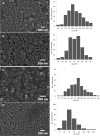Encapsulation of the dual FLAP/mPEGS-1 inhibitor BRP-187 into acetalated dextran and PLGA nanoparticles improves its cellular bioactivity
- PMID: 32408877
- PMCID: PMC7227278
- DOI: 10.1186/s12951-020-00620-7
Encapsulation of the dual FLAP/mPEGS-1 inhibitor BRP-187 into acetalated dextran and PLGA nanoparticles improves its cellular bioactivity
Erratum in
-
Correction: Encapsulation of the dual FLAP/mPEGS‑1 inhibitor BRP‑187 into acetalated dextran and PLGA nanoparticles improves its cellular bioactivity.J Nanobiotechnology. 2024 Feb 27;22(1):77. doi: 10.1186/s12951-024-02341-7. J Nanobiotechnology. 2024. PMID: 38408973 Free PMC article. No abstract available.
Abstract
Background: Dual inhibitors of the 5-lipoxygenase-activating protein (FLAP) and the microsomal prostaglandin E2 synthase-1 (mPGES-1) may exert better anti-inflammatory efficacy and lower risks of adverse effects versus non-steroidal anti-inflammatory drugs. Despite these advantages, many dual FLAP/mPGES-1 inhibitors are acidic lipophilic molecules with low solubility and strong tendency for plasma protein binding that limit their bioavailability and bioactivity. Here, we present the encapsulation of the dual FLAP/mPGES-1 inhibitor BRP-187 into the biocompatible polymers acetalated dextran (Acdex) and poly(lactic-co-glycolic acid) (PLGA) via nanoprecipitation.
Results: The nanoparticles containing BRP-187 were prepared by the nanoprecipitation method and analyzed by dynamic light scattering regarding their hydrodynamic diameter, by scanning electron microscopy for morphology properties, and by UV-VIS spectroscopy for determination of the encapsulation efficiency of the drug. Moreover, we designed fluorescent BRP-187 particles, which showed high cellular uptake by leukocytes, as analyzed by flow cytometry. Finally, BRP-187 nanoparticles were tested in human polymorphonuclear leukocytes and macrophages to determine drug uptake, cytotoxicity, and efficiency to inhibit FLAP and mPGES-1.
Conclusion: Our results demonstrate that encapsulation of BRP-187 into Acdex and PLGA is feasible, and both PLGA- and Acdex-based particles loaded with BRP-187 are more efficient in suppressing 5-lipoxygenase product formation and prostaglandin E2 biosynthesis in intact cells as compared to the free compound, particularly after prolonged preincubation periods.
Keywords: Acetalated dextran; BRP-187; Dual inhibitor; FLAP inhibitor; Leukotriene biosynthesis; MPGES-1; Nanoparticles; PLGA.
Conflict of interest statement
The authors declare that they have no competing interests.
Figures







Similar articles
-
Effect of Crystallinity on the Properties of Polycaprolactone Nanoparticles Containing the Dual FLAP/mPEGS-1 Inhibitor BRP-187.Polymers (Basel). 2021 Jul 31;13(15):2557. doi: 10.3390/polym13152557. Polymers (Basel). 2021. PMID: 34372160 Free PMC article.
-
Optimized Encapsulation of the FLAP/PGES-1 Inhibitor BRP-187 in PVA-Stabilized PLGA Nanoparticles Using Microfluidics.Polymers (Basel). 2020 Nov 20;12(11):2751. doi: 10.3390/polym12112751. Polymers (Basel). 2020. PMID: 33233853 Free PMC article.
-
Ethoxy acetalated dextran-based nanocarriers accomplish efficient inhibition of leukotriene formation by a novel FLAP antagonist in human leukocytes and blood.Cell Mol Life Sci. 2021 Dec 31;79(1):40. doi: 10.1007/s00018-021-04039-7. Cell Mol Life Sci. 2021. PMID: 34971430 Free PMC article.
-
BRP-187: A potent inhibitor of leukotriene biosynthesis that acts through impeding the dynamic 5-lipoxygenase/5-lipoxygenase-activating protein (FLAP) complex assembly.Biochem Pharmacol. 2016 Nov 1;119:17-26. doi: 10.1016/j.bcp.2016.08.023. Epub 2016 Aug 31. Biochem Pharmacol. 2016. PMID: 27592027
-
The novel benzimidazole derivative BRP-7 inhibits leukotriene biosynthesis in vitro and in vivo by targeting 5-lipoxygenase-activating protein (FLAP).Br J Pharmacol. 2014 Jun;171(12):3051-64. doi: 10.1111/bph.12625. Br J Pharmacol. 2014. PMID: 24641614 Free PMC article.
Cited by
-
Correction: Encapsulation of the dual FLAP/mPEGS‑1 inhibitor BRP‑187 into acetalated dextran and PLGA nanoparticles improves its cellular bioactivity.J Nanobiotechnology. 2024 Feb 27;22(1):77. doi: 10.1186/s12951-024-02341-7. J Nanobiotechnology. 2024. PMID: 38408973 Free PMC article. No abstract available.
-
Molecular Pharmacology of Inflammation Resolution in Atherosclerosis.Int J Mol Sci. 2022 Apr 27;23(9):4808. doi: 10.3390/ijms23094808. Int J Mol Sci. 2022. PMID: 35563200 Free PMC article. Review.
-
Effect of Crystallinity on the Properties of Polycaprolactone Nanoparticles Containing the Dual FLAP/mPEGS-1 Inhibitor BRP-187.Polymers (Basel). 2021 Jul 31;13(15):2557. doi: 10.3390/polym13152557. Polymers (Basel). 2021. PMID: 34372160 Free PMC article.
-
Optimized Encapsulation of the FLAP/PGES-1 Inhibitor BRP-187 in PVA-Stabilized PLGA Nanoparticles Using Microfluidics.Polymers (Basel). 2020 Nov 20;12(11):2751. doi: 10.3390/polym12112751. Polymers (Basel). 2020. PMID: 33233853 Free PMC article.
-
Sustainability in Drug and Nanoparticle Processing.Handb Exp Pharmacol. 2024;284:45-68. doi: 10.1007/164_2023_659. Handb Exp Pharmacol. 2024. PMID: 37306814
References
MeSH terms
Substances
Grants and funding
LinkOut - more resources
Full Text Sources

